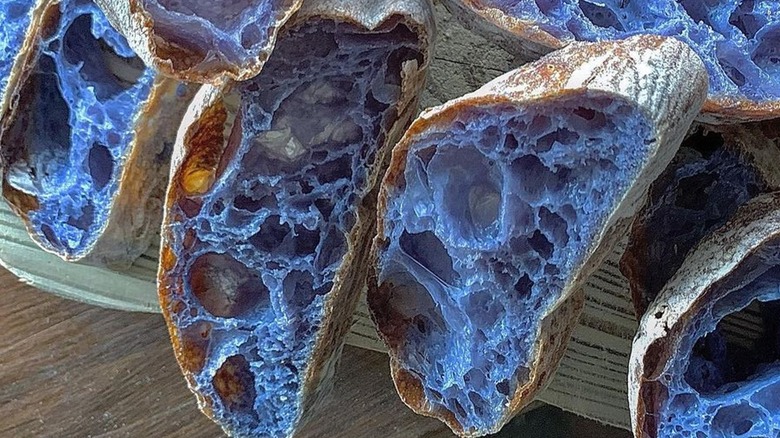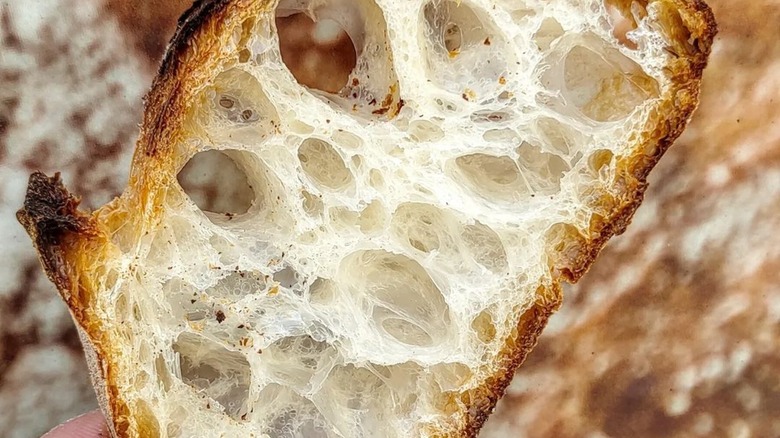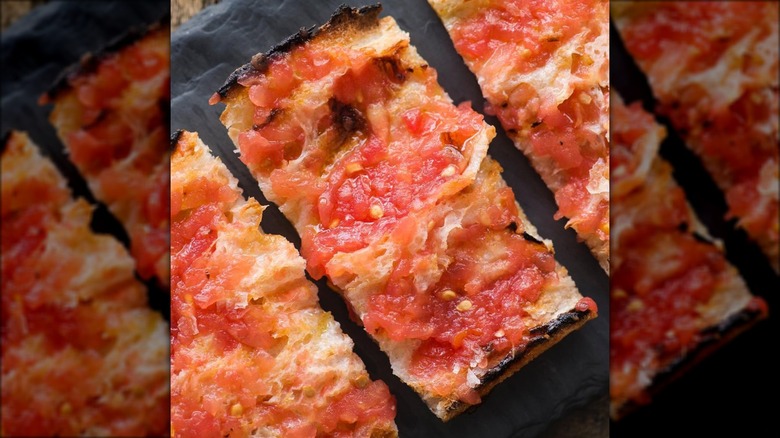What Is Pan De Cristal And What Does It Taste Like?
Pan de cristal is a Spanish phrase that means "glass bread" and at first glance, the name looks like the world's worst descriptor. There is nothing remotely transparent about this seemingly dense loaf — it's just a solid brown log on the outside. Underneath the crust, though, it hides a surprise: This bread is holier than Vatican City at Eastertime.
Presumably, the "glass" part of the name is meant to refer to the "windows" that appear in the loaf since instead of crumbs, the gluten in the dough forms what appears more like a bread version of Swiss cheese. As for the taste, it tastes, well, bready. Yeasty, Kind of plain as there are no special ingredients other than the extra-high protein flour needed to retain the high moisture level that makes the dough take on its holey appearance, although it's possible to make a sourdough version that tastes like sourdough (or sour dough). The texture, though, is crunchy on the outside and airy inside. In short, pan de cristal is the perfect loaf for those who really only enjoy the crust and don't care for all the bready stuff inside.
History of pan de cristal
The name "pan de cristal" might sound like something that dates back into the mists of time, and indeed, some sources have apparently been fooled into calling the bread a "traditional" Spanish one. Well, that's playing pretty fast and loose with the definition of the term, if you ask us, since the bread only goes back about a decade and can be traced to one specific baker in an original story not dissimilar to that of the equally "traditional" cronut. Those unnamed sources are right about the Spanish part, though, as the bread was created in that country.
Pan de cristal was birthed in Barcelona back around the turn of the 20-tweens to the best of our knowledge. The baker who fathered it was one Jordi Nomen by name and the immaculate conception of this holey loaf took place, not in a manger, but at a bakery called Concept Pa. It seems as if Nomen may have based his recipe on an older Catalonian bread, though, which checks out since most new recipes are based on previous ones. (In the food world, as in most spheres, there really is nothing new under the sun.)
What goes into pan de cristal?
Pan de cristal is, as we've mentioned, generally a pretty plain bread. In fact, in baker's terms, it could be described as "lean" since it typically only contains flour (of the high protein kind meant for bread), yeast, salt, and water. A whole lot of water. Way more water than you've ever imagined using in bread, at least unless you've made this kind before, since the water, as it turns out, is key to getting those huge holes in the loaf.
Bakers categorize bread types by their hydration level, with anything 75% and up being considered high hydration — ciabatta, which also tends to have pretty big holes, sits around the 75% mark. Pan de cristal, however, comes in right around 100% hydration. What this means is that the water-to-flour ratio is 1:1, and yes, this does make for a very wet dough that's actually more like a batter in nature. Thanks to the protein in the flour, though, as well as some baker's magic, if all goes well it won't come out of the oven flat like a pancake but should rather rise up into a standard bread loaf shape.
How pan de cristal is made
Making pan de cristal is quite the undertaking, and not one for beginning bakers. Or even intermediate ones, for that matter, unless they're really up for a challenge. We're not going to lay out a step-by-step process here as that would require a whole 'nother article, but the gist of it is that you mix up your dough, let it rest in a warm spot for a short while, then start folding (not kneading). Rest it some more, fold it some more, then keep repeating the process until the dough, which starts off as more of a batter, has stiffened up to the point where it can be shaped into loaves. At that point, you bake the bread, cool it, and eat it.
Sounds deceptively simple, no? Well, if you're a professional baker with years of experience under your belt, it just might be. Not everyone finds the bread to be foolproof, though. Some home bakers report that when they've tried baking pan de cristal, it comes out of the oven flat, while others never can get the dough to stiffen up and say that it stays a mushy mess. Any type of bread dough can be capricious under the best of circumstances, and high hydration dough especially so. As a result, it seems that if the stars aren't aligned just right, pan de cristal can be a real headache to make.
Where to buy pan de cristal
When you Google pan de cristal, you're likely to be bombarded with recipes for the stuff, since despite the inherent difficulty it seems to be quite a trendy baking project. But let's face it: Not all of us are equipped to, or even interested in, making our own. Unfortunately, it seems many bakeries may agree since a 2020 Reddit post dealt with the impossibility of tracing down a place to buy the stuff in Chicago. We haven't been successful in tracking down many bakeries in other regions of the country that do; although Sacsourdoughbread in Sacramento has been known to sell it.
Your best bet for buying pan de cristal may be from a grocer specializing in Spanish imports, Florida-based La Jamoteca sells it, as does La Española Meats, located in the Los Angeles suburb of Harbor City. Pan de cristal can be purchased online, as well. La Tienda, a web store specializing in Spanish imports, lists two loaves for $22, although increasing the number (in multiples of two) drops the price down a bit. An online vendor called the Spanish Club also offers pan de cristal for purchase, but unfortunately for us (or U.S.), it only delivers to the Netherlands.
How to eat pan de cristal
Pan de cristal is bread, so of course it is well-suited to making sandwiches. Closed ones, open-faced ones, grilled cheese, it can make a great base for any and all of these. If you want to stick with a Spanish theme you could do a kind of Iberian version of an Italian sub with Spanish-style chorizo, which is the hard, pepperoni-like kind, and manchego, the Spanish cheese with the ridgey rind. You might also delve into fusion cuisine by making a pan de cristal PBJ or fluffernutter. While the latter in particular might make for a surprising choice, there's no reason that it wouldn't work.
If you really want to be traditional, though (assuming that term can be used for something less than 15 years old), you can use pan de cristal to make the Spanish open-faced sandwich-pizza mashup called pan con tomate (tomato bread). While the dish dates back at least as far as the 19th century, thus long predating the bread itself, pan de cristal is well suited for the toppings of olive oil, garlic, and tomatoes. The reason for this is that a less crusty loaf might leak, while one with a less holey (and thus breadier) interior might become mushy. By this token, pan de cristal might also be your loaf of choice for egg salad, tuna salad, and similarly soggy sandwich fillings.





